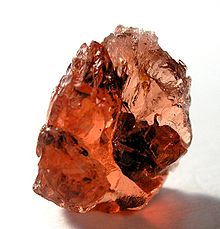| Triplite | |
|---|---|
 Triplite from Alchuri, Shigar Valley, Baltistan, Pakistan (1.2 × 1 × 0.9 cm) | |
| General | |
| Category | Phosphate minerals |
| Formula (repeating unit) | (Mn,Fe)2(PO4)(F,OH) |
| IMA symbol | Trl[1] |
| Strunz classification | 8.BB.10 |
| Crystal system | Monoclinic |
| Crystal class | Prismatic (2/m) (same H-M symbol) |
| Space group | I2/a (no. 15) |
| Unit cell | a = 11.97 Å, b = 6.52 Å c = 10.09 Å; β = 105.62°; Z = 8 |
| Identification | |
| Color | Chestnut to reddish brown, flesh-red, salmon-pink |
| Crystal habit | Prismatic, massive to nodular |
| Cleavage | Good on {001}, fair on {010}, poor on {100} |
| Fracture | Uneven to subconchoidal |
| Mohs scale hardness | 5 to 5.5 |
| Luster | Vitreous to resinous |
| Streak | White to brown |
| Diaphaneity | Translucent to opaque |
| Specific gravity | 3.5 – 3.9 |
| Optical properties | Biaxial (+) |
| Refractive index | nα=1.643–1.684, nβ=1.647–1.693, nγ=1.668–1.703 |
| Pleochroism | Distinct; yellow-brown to reddish brown |
| 2V angle | 25 – 76° |
| Dispersion | r > v, moderate to strong |
| Alters to | Alters to brownish black |
| References | [2][3][4][5] |
Triplite is a rare phosphate mineral with formula: (Mn, Fe)2PO4(F, OH). It occurs in phosphate-rich granitic pegmatites typically as irregular brown opaque masses. Triplite was first described in 1813 for an occurrence in Chanteloube, Limousin, France.[6] The name is from the Greek triplos for triple, in reference to the three cleavage directions.[3] In color and appearance, it is very similar to rhodocrosite, another manganese bearing mineral. Chemically, it is also quite similar to triploidite the difference being that triplite is fluorine dominant while triploidite is hydroxide dominant.
- ^ Warr, L.N. (2021). "IMA–CNMNC approved mineral symbols". Mineralogical Magazine. 85 (3): 291–320. Bibcode:2021MinM...85..291W. doi:10.1180/mgm.2021.43. S2CID 235729616.
- ^ Handbook of Mineralogy
- ^ a b Mindat.org
- ^ Webmineral data
- ^ Vignola, Pietro; Gatta, G. Diego; Hatert, Frédéric; Guastoni, Alessandro; Bersani, Danilo (April 2014). "ON THE CRYSTAL-CHEMISTRY OF A NEAR-ENDMEMBER TRIPLITE, Mn 2+ 2 (PO 4 )F, FROM THE CODERA VALLEY (SONDRIO PROVINCE, CENTRAL ALPS, ITALY)". The Canadian Mineralogist. 52 (2): 235–245. doi:10.3749/canmin.52.2.235.
- ^ Triplite Crystals from Colorado, C. W. Wolf and E. Wm. Heinrich, American Mineralogist, Volume 32, pages 518–526, 1947